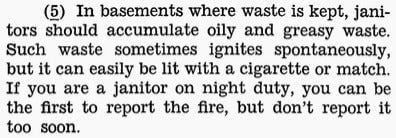How to sabotage your enemies—or colleagues—using time-tested tips from the CIA
In 1944 the US Office for Strategic Services, the precursor to the Central Intelligence Agency (CIA), published a handy field guide to sabotaging one’s enemy (pdf).


In 1944 the US Office for Strategic Services, the precursor to the Central Intelligence Agency (CIA), published a handy field guide to sabotaging one’s enemy (pdf).
Its 32 pages of tips and tricks make for a fascinating read. But it is the cool-headed language employed to instruct operatives—whether undercover as janitors or executives—on how to carry out such wicked acts as burning down a building that makes the guide really special.

In the chapter titled Specific Suggestions for Simple Sabotage, the guide suggests: “In basements where waste is kept, janitors should accumulate oily and greasy waste. Such waste sometimes ignites spontaneously, but it can easily be lit with a cigarette or match. If you are a janitor on night duty, you can be the first to report the fire, but don’t report it too soon.”
The book gives advice on how a visitor can damage a company or how a workers can confuse the enemy in public. Interestingly, it also gives advice on sabotaging a company from within. That section reads much like a manual for how to be the worst boss imaginable.
Here are a few Quartz favorites:
Before getting into strategies, the Tools, Targets, and Timing chapter advises on some general outlines, such as thinking outside the box:
4 (1) (b). The saboteur should be ingenious in using his everyday equipment. All sorts of weapons will present themselves if he looks at his surroundings in a different light. For example emery dust—a powerful weapon—may at first seem unobtainable, but if the saboteur were to pulverize an emery knife sharpener or emery wheel with a hammer, he would find himself with a plentiful supply.
Chapter five brings us to the exciting bits. Maybe you’ve gained access to a building as a visitor? Head to the restroom:
5 (b) (2). Saturate a sponge with a thick starch or sugar solution. Squeeze it tightly into a ball, wrap it with string, and dry. Remove the string when fully dried. The sponge will be in the form of a tight hard ball. Flush down a WC or otherwise introduce into a sewer line. The sponge will gradually expand to its normal size and plug the sewage system.
Or better, you’ve gained access to a company by working in the factory. In that case, remember:
5 (2) (a) (1). Let cutting tools grow dull. They will be inefficient, will slow down production, and may damage the materials and parts you use them on.
Perhaps you’re in the office, pushing paper. The guidebook says do as much of that as possible:
5 (11) (a) (2). Make “speeches.” Talk as frequently as possible and at great length. Illustrate your “points” by long anecdotes and accounts of personal experiences. Never hesitate to make a few appropriate “patriotic” comments.
5 (11) (a) (3). When possible, refer all matters to committees, for “further study and consideration.” Attempt to make the committees as large as possible—never less than five.
5 (11) (a) (6). Refer back to matters decided upon at the last meeting and attempt to re-open the question of the advisability of that decision.
Should you be promoted after all of that, there is yet more advice:
5 (11) (b) (1). Demand written orders.
5 (11) (b) (2). “Misunderstand” orders.
5 (11) (b) (10). To lower morale and with it, productivity, be pleasant to inefficient workers; give them undeserved promotions. Discriminate against efficient worker; complain unjustly about their work.
Finally, one useful sabotage strategy that many people in companies today would recognize:
5 (11) (b) (11). Hold conferences when there is more critical work to be done.